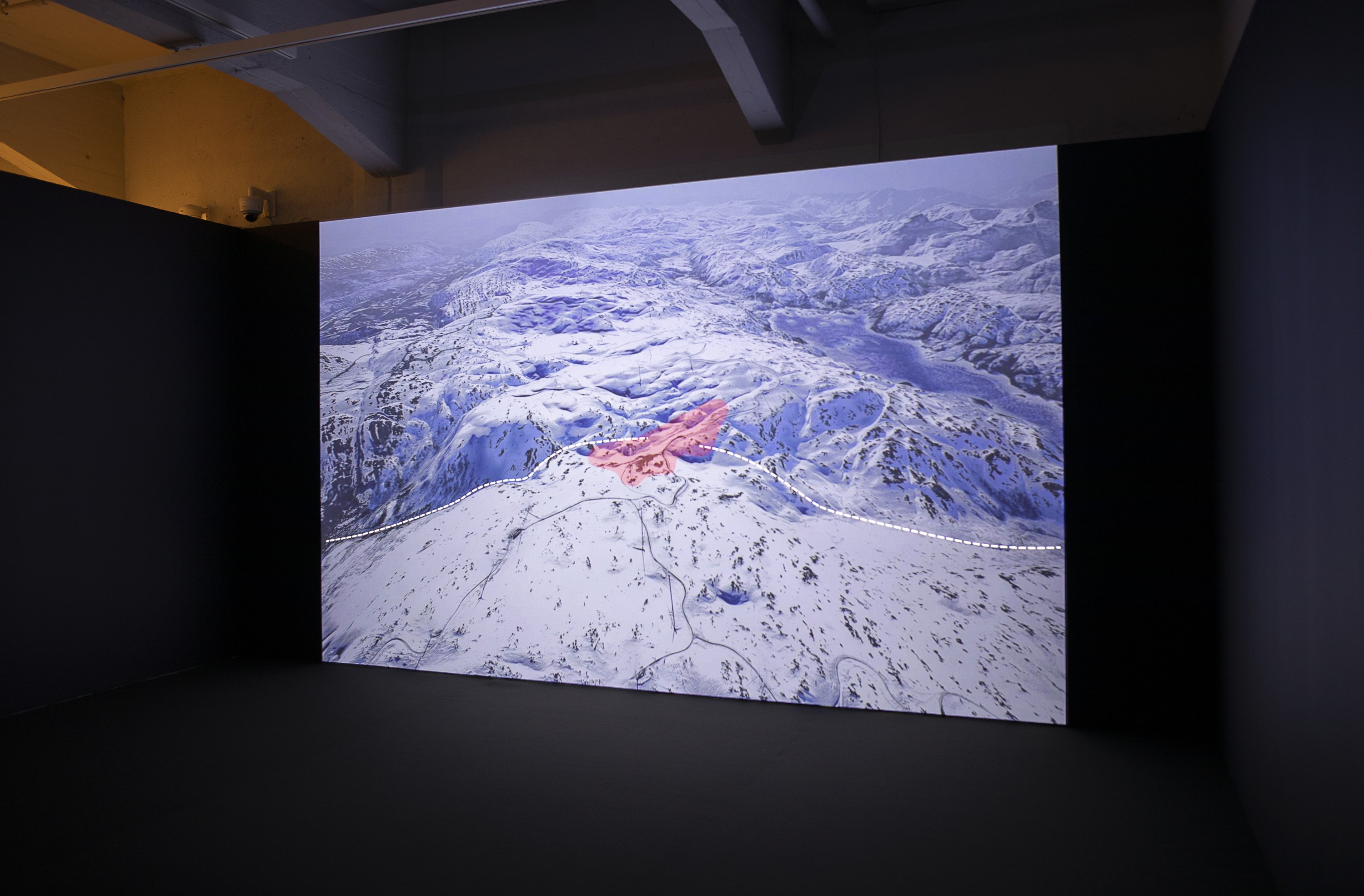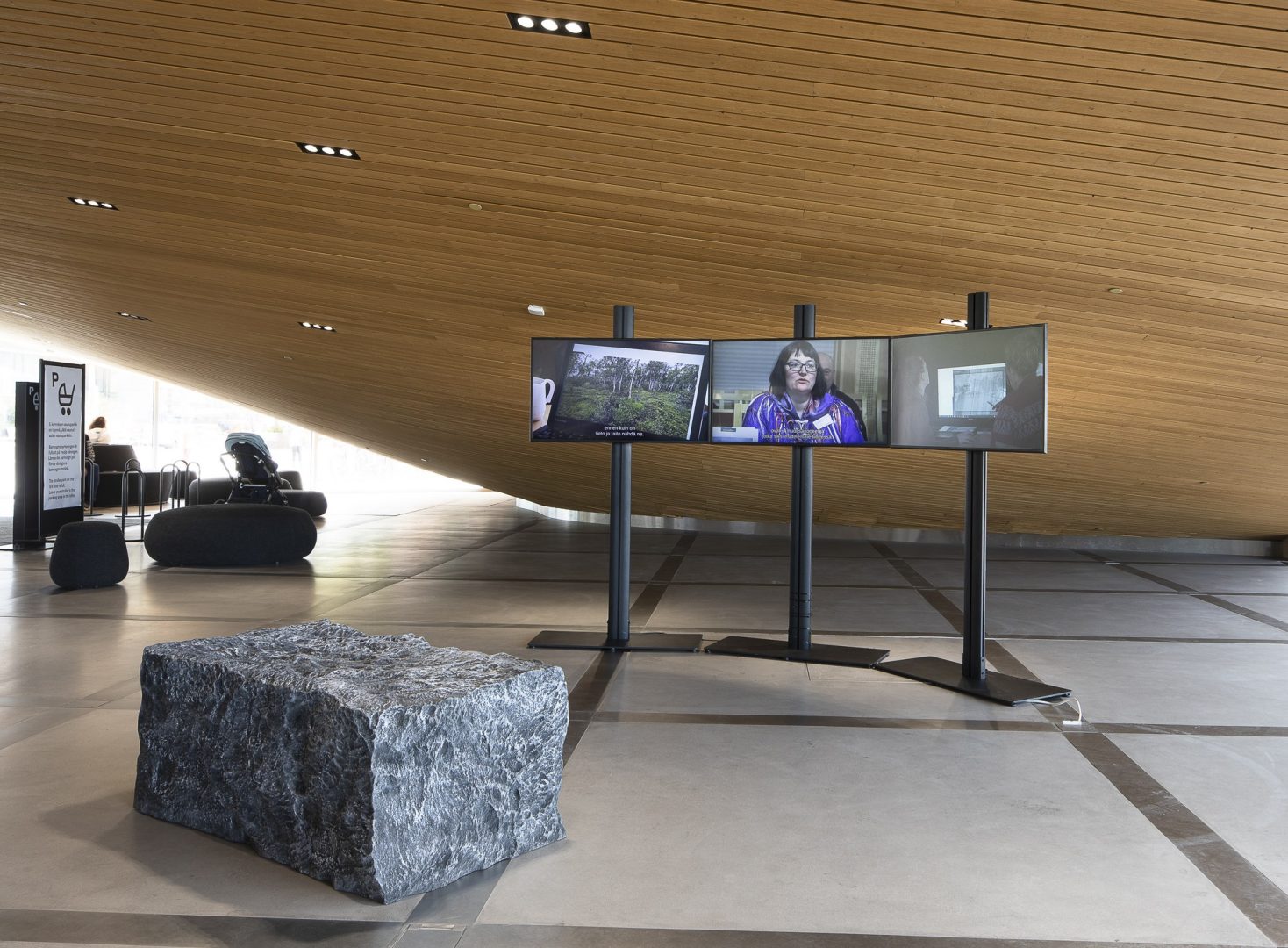INTERPRT is a research agency that engages with environmental justice and human rights. Through spatial and visual investigations by its team of academics, architects, and spatial designers, working in collaboration with civil society organizations, international lawyers, scientists, NGOs, journalists, and leading cultural institutions worldwide, they focus on the representation of difficult-to-trace environmental destruction and resistance to extractive projects mounted by indigenous, minority and marginalized groups.
In their new work for Helsinki Biennial 2023, INTERPRT asked if the Nordic truth commissions can sufficiently expose and examine the colonial history of assimilation, land dispossession and other forms of state violence that continue in the present in the form of green colonialism. The project is a further exploration of INTERPRT’s long-standing collective research and advocacy concerns.
For Helsinki, INTERPRT produced a multimedia report and installation combining visual and cartographic evidence, environmental data, spatial methodologies with field research, interviews, and archival sources. In particular, the project tells the spatial story of the ongoing legal struggle between Sámi reindeer herder communities and wind power projects in Øyfjellet in Nordland county in Northern Norway. The aim is to create a new form of data journalism project in cooperation with Sámi journalists, archaeologists, and researchers that critically engages with transitional and climate justice in the colonial present.
INTERPRT’s installation was displayed at HAM Helsinki Art Museum and Helsinki Central Library Oodi.
In 2018, INTERPRT’s Nabil Ahmed, together with the Office for Contemporary Art Norway (OCA), initiated the ‘Fighting Environmental Crime in West Papua’ workshop for OCA’s ‘Let the River Flow’ exhibition, which dealt with the role of Sámi artists in the Alta Action and contemporary artistic positions on eco-political indigenous struggles and rights to self-determination. The Alta Action (c. 1978 – 82) involved Sámi and non-Sámi activists staging massive protests against the construction of a hydroelectric power plant on the Alta River.
The workshop brought together West Papuan leaders, and human rights defenders fighting for self-determination in dialogue with their Sámi counterparts. We met at the Árdna – the Sámi cultural building of The Arctic University of Norway’s Centre for Sámi Studies in Tromsø. The workshop created the opportunity for our honoured guests from West Papua to share stories of their struggles against industrial mining and oppression by the Indonesian state, which INTERPRT has also been documenting since 2014.
At the Árdna hangs ‘The Crows/Garjjat’ (1981), an artwork on the Alta action by the Sámi artist Britta Marakatt-Labba. In the work, a long line of crows flies in from the distant horizon in a landscape of snow and ice. As the crows swoop down, they turn into police officers who attack the Sámi seated by their lavvos (shelters). Upon seeing ‘The Crows’, Mama Yosepha Alomang – a Papuan community leader who has led the resistance to mining on her ancestral land over many decades – said to us that this was also what happened to her people. Her words still resonate with us today.
INTERPRT

INTERPRT: Colonial Present: Counter-mapping the Truth and Reconciliation Commissions in Sápmi,2023. © HAM/Helsinki Biennial/Sonja Hyytiäinen

INTERPRT: Colonial Present: Counter-mapping the Truth and Reconciliation Commissions in Sápmi,2023. © HAM/Helsinki Biennial/Sonja Hyytiäinen
INTERPRT’s recent international and institutional exhibitions include Forensic Architecture: Towards an Investigative Aesthetics, MACBA, Barcelona, Spain (2017); The Oceanic, NTU CCA, Singapore (2018); Dhaka Art Summit, Dhaka, Bangladesh (2018), Museum of Modern Art, Warsaw, Poland (2019); Biennale Warszawa, Warsaw, Poland (2020), The Ocean, Bergen Kunsthall, Bergen, Norway (2021) and Mining the Abyss, Istanbul Biennale, Istanbul (2022).
INTERPRT
Colonial Present: Counter-mapping the Truth and Reconciliation Commissions in Sápmi
2023
multimedia report and installation
Co-investigators: Nabil Ahmed and Olga Lucko
Architectural research: Tiago Patatas
Research: Esther Breslin
3D development: Gwil Hughes and Mingxin Li
Remote sensing analysis: Paulo J. Murillo-Sandoval
Filming: Marius Reed, Nikolas Flotsky, Dixin Wang and Prerna Bishnoi
Video editing and production: Prerna Bishnoi and Filip Wesołowski
Video editing assistance: Gustav Gundvalsen
Thanks to: Hanne Svinsås Magga, Mattis Danielsen, Ole Henrik Kappfjell, Torstein Appfjell, Berit Kristin Hætta, Pål Gude Gudesen, Knut Helge Hurum, Ingjerd Tjelle, Sverre Fjellheim, Eva Maria Fjellheim, Ingrid Fadnes, Magnus Holmen, Manuela Panzacchi, Bernardo Brandão Niebuhr Dos Santos, Martinus Suijkerbuijk, Ernestine Boiling, and Katya García-Antón.
STUDIO INTERPRT is based at the Trondheim Academy of Fine Art in the Faculty of Architecture and Design at NTNU.
Comissioned by HAM/Helsinki Biennial 2023